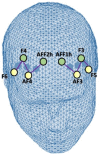Interoceptive Attentiveness Induces Significantly More PFC Activation during a Synchronized Linguistic Task Compared to a Motor Task as Revealed by Functional Near-Infrared Spectroscopy
- PMID: 35326258
- PMCID: PMC8946073
- DOI: 10.3390/brainsci12030301
Interoceptive Attentiveness Induces Significantly More PFC Activation during a Synchronized Linguistic Task Compared to a Motor Task as Revealed by Functional Near-Infrared Spectroscopy
Abstract
Currently, there is little understanding of how interoceptive attentiveness (IA) affects brain responses during synchronized cognitive or motor tasks. This pilot study explored the effect of explicit IA manipulation on hemodynamic correlates of simple cognitive tasks implying linguistic or motor synchronization. Eighteen healthy participants completed two linguistic and motor synchronization tasks during explicit IA and control conditions while oxygenated (O2Hb) and deoxygenated (HHb) hemoglobin variations were recorded by functional Near-Infrared Spectroscopy (fNIRS). The findings suggested that the brain regions associated with sustained attention, such as the right prefrontal cortex (PFC), were more involved when an explicit focus on the breath was induced during the cognitive linguistic task requiring synchronization with a partner, as indicated by increased O2Hb. Interestingly, this effect was not significant for the motor task. In conclusion, for the first time, this pilot research found increased activity in neuroanatomical regions that promote sustained attention, attention reorientation, and synchronization when a joint task is carried out and the person is focusing on their physiological body reactions. Moreover, the results suggested that the benefits of conscious concentration on physiological interoceptive correlates while executing a task demanding synchronization, particularly verbal alignment, may be related to the right PFC.
Keywords: PFC; cognitive tasks; fNIRS; interoceptive attentiveness; synchronization.
Conflict of interest statement
The authors declare no conflict of interest.
Figures




Similar articles
-
EEG brain oscillations are modulated by interoception in response to a synchronized motor vs. cognitive task.Front Neuroanat. 2022 Sep 23;16:991522. doi: 10.3389/fnana.2022.991522. eCollection 2022. Front Neuroanat. 2022. PMID: 36213612 Free PMC article.
-
The Increasing Effect of Interoception on Brain Frontal Responsiveness During a Socially Framed Motor Synchronization Task.Front Hum Neurosci. 2022 May 20;16:834619. doi: 10.3389/fnhum.2022.834619. eCollection 2022. Front Hum Neurosci. 2022. PMID: 35669205 Free PMC article.
-
A semi-immersive virtual reality incremental swing balance task activates prefrontal cortex: a functional near-infrared spectroscopy study.Neuroimage. 2014 Jan 15;85 Pt 1:451-60. doi: 10.1016/j.neuroimage.2013.05.031. Epub 2013 May 17. Neuroimage. 2014. PMID: 23684867
-
Functional Near-Infrared Spectroscopy to Study Cerebral Hemodynamics in Older Adults During Cognitive and Motor Tasks: A Review.Front Aging Neurosci. 2020 Jan 21;11:367. doi: 10.3389/fnagi.2019.00367. eCollection 2019. Front Aging Neurosci. 2020. PMID: 32038224 Free PMC article. Review.
-
The prefrontal cortex hemodynamic responses to dual-task paradigms in older adults: A systematic review and meta-analysis.Heliyon. 2023 Jul 6;9(7):e17812. doi: 10.1016/j.heliyon.2023.e17812. eCollection 2023 Jul. Heliyon. 2023. PMID: 37519646 Free PMC article. Review.
Cited by
-
NiReject: toward automated bad channel detection in functional near-infrared spectroscopy.Neurophotonics. 2024 Oct;11(4):045008. doi: 10.1117/1.NPh.11.4.045008. Epub 2024 Nov 4. Neurophotonics. 2024. PMID: 39497725 Free PMC article.
-
EEG brain oscillations are modulated by interoception in response to a synchronized motor vs. cognitive task.Front Neuroanat. 2022 Sep 23;16:991522. doi: 10.3389/fnana.2022.991522. eCollection 2022. Front Neuroanat. 2022. PMID: 36213612 Free PMC article.
-
Autonomic synchrony induced by hyperscanning interoception during interpersonal synchronization tasks.Front Hum Neurosci. 2023 Jul 21;17:1200750. doi: 10.3389/fnhum.2023.1200750. eCollection 2023. Front Hum Neurosci. 2023. PMID: 37545591 Free PMC article.
-
Dyadic inter-brain EEG coherence induced by interoceptive hyperscanning.Sci Rep. 2023 Mar 16;13(1):4344. doi: 10.1038/s41598-023-31494-y. Sci Rep. 2023. PMID: 36927763 Free PMC article.
-
Social Interoception and Autonomic System Reactivity during Synchronization Behavior.Behav Sci (Basel). 2024 Feb 20;14(3):149. doi: 10.3390/bs14030149. Behav Sci (Basel). 2024. PMID: 38540452 Free PMC article.
References
-
- Tsakiris M., De Preester H. The Interoceptive Mind: From Homeostasis to Awareness. Oxford University Press; Oxford, UK: 2018.
LinkOut - more resources
Full Text Sources
Miscellaneous

